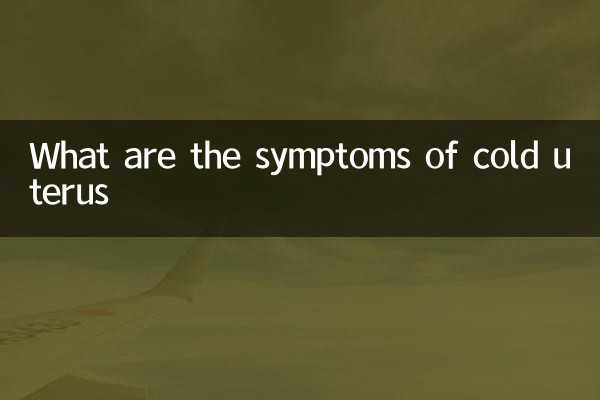What is uterine cold? Symptoms of uterine cold
Uterine cold is a common concept in traditional Chinese medicine, which refers to the fact that a woman's uterus is cold, which leads to poor circulation of qi and blood, causing a series of discomfort symptoms. Uterine cold is not the name of disease in modern medicine, but in traditional Chinese medicine theory, it is closely related to female reproductive health. In recent years, with the popularization of health knowledge, gonghan has become a hot topic on the Internet, especially the female group has paid more attention to it. This article will introduce in detail the definition, symptoms, causes and conditioning methods of uterine cold to help everyone better understand and deal with this problem.
1. Definition of uterine cold

As the name suggests, uterine cold refers to the uterus being in a "cold" state. Traditional Chinese medicine believes that the uterus is an important reproductive organ for women, and its health is closely related to the circulation of qi and blood. If the uterus is cold, it will cause qi and blood stagnation, affecting menstruation, fertility and other functions. Uterine cold is not a single disease, but a physical condition or symptom manifestation, which may be caused by a variety of factors.
2. Symptoms of uterine cold
There are many symptoms of uterine cold, and the following are some common symptoms:
| Symptom Category | Specific performance |
|---|---|
| Menstrual abnormalities | Delayed menstruation, small menstrual blood volume, dark red or black color, many blood clots, dysmenorrhea |
| Physical discomfort | Cold hands and feet, cold abdomen, sore waist and knees, fear of coldness |
| Reproductive problems | Infertility, habitual miscarriage, and high leucorrhea |
| Other symptoms | Pale complexion, low spirits, easy to get tired |
3. Causes of cold uterus
The formation of uterine cold is related to a variety of factors, mainly including the following aspects:
| Cause category | Specific instructions |
|---|---|
| Living habits | Wear a navel-exposed dress for a long time, drink coldly, and over-dry air conditioning |
| Physical factors | Insufficient yang energy and weak qi and blood |
| Environmental factors | Living in a cold and humid environment for a long time |
| Emotional stress | Long-term depression and excessive stress lead to poor qi and blood |
4. Methods for uterine cold conditioning
If uterine cold symptoms occur, you can use the following methods to regulate:
| Conditioning method | Specific measures |
|---|---|
| Diet conditioning | Eat more warm foods such as red dates, ginger, and longan; avoid raw, cold and cold foods |
| Living habits | Pay attention to keeping warm, especially the abdomen and feet; avoid sitting for a long time |
| Traditional Chinese Medicine Conditioning | Moxibustion, cupping, and traditional Chinese medicine conditioning (need to be carried out under the guidance of a professional doctor) |
| Exercise exercise | Proper exercise such as yoga and walking to promote qi and blood circulation |
5. Prevention of cold uterine
Preventing uterine cold is more important than treating. Here are some prevention suggestions:
1.Keep warm: Especially during menstruation and winter, avoid wearing navel-exposed clothes or short skirts.
2.Eat reasonably: Eat less cold foods such as ice cream and cold drinks, and drink more warm water.
3.Regulate emotions: Keep a happy mood and avoid long-term emotional depression.
4.Moderate exercise: Strengthen physical fitness and improve qi and blood circulation.
6. Summary
Uterine cold is a common health problem in women. Although it is not a serious disease, long-term neglect may affect reproductive health and daily life. By understanding the symptoms and causes of uterine cold and taking scientific conditioning and preventive measures, we can effectively improve physical fitness and improve our quality of life. If the symptoms are serious or continue to relieve, it is recommended to seek medical treatment in time and seek help from professional Chinese medicine practitioners.

check the details

check the details